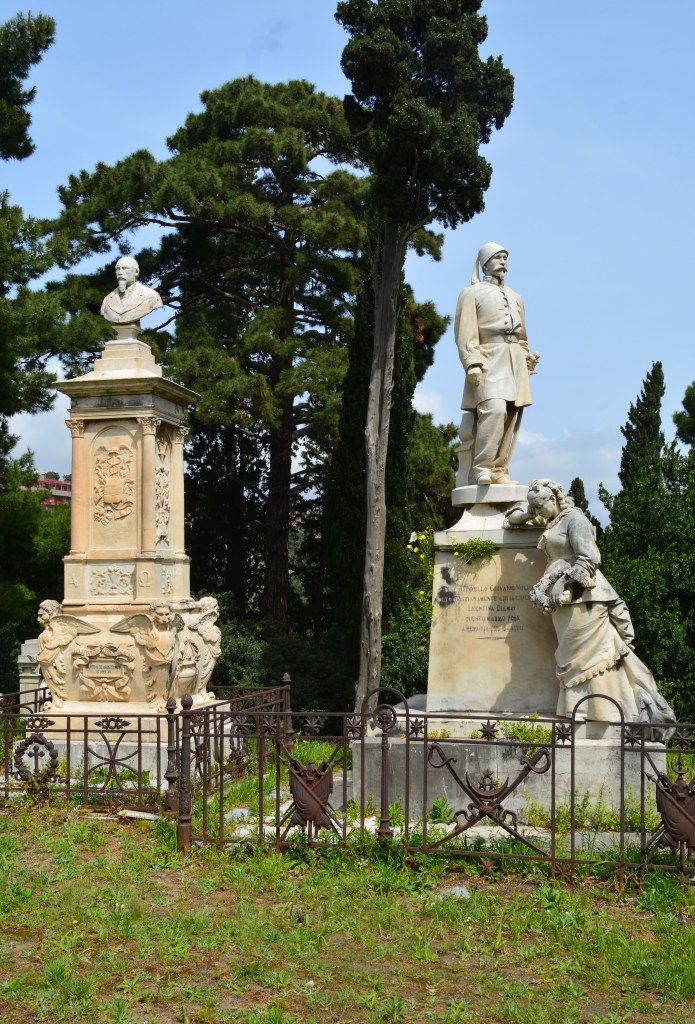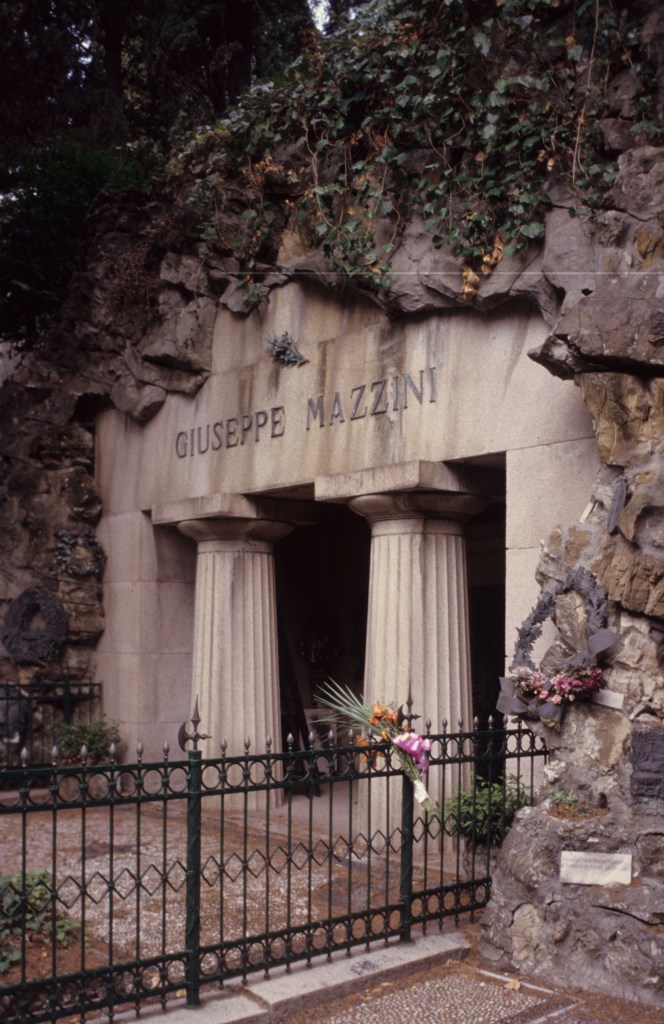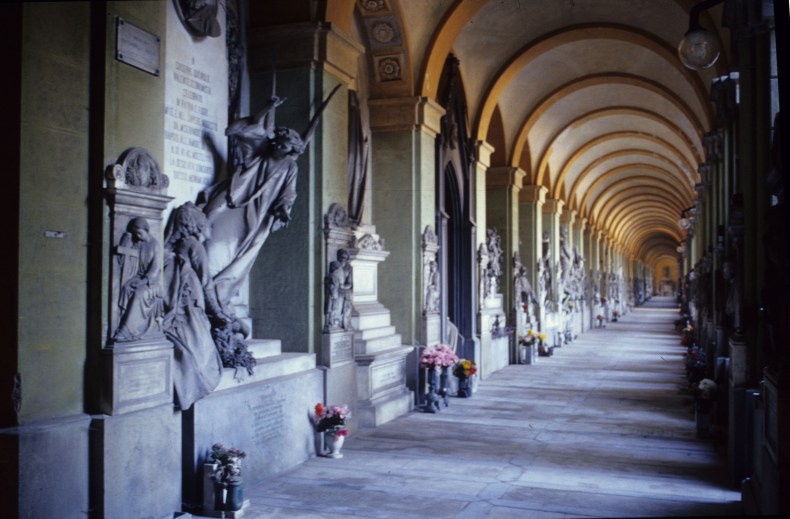The history of a nation, a city, or a culture, is written in stone in its cemeteries, and a society may be judged by the way it treats and remembers its dead. In England we have the churchyard – all too often these days with once-handsome headstones stacked irreverently around the perimeter – and the great Victorian planned urban cemeteries, full of elaborate tombs (but usually suffering from decades of neglect and vandalism, even if now being restored by voluntary organisations). Across the Channel, the history of modern France can be read in the three great cemeteries of Paris: Père-Lachaise, Montparnasse, and Montmartre, where monuments to the famous – artists, as well as politicians and generals – are disposed along leafy, winding paths. But for grand architecture, extravagant private chapels, and extraordinary works of sculpture, nothing compares with the huge monumental cemeteries to be found outside most of the great cities of Italy.
The Monumentale in Milan, the Verano cemetery in Rome, the Staglieno in Genoa and some 20 others: all make Highgate and Kensal Green, and even the wonderful Necropolis in Glasgow seem mean and provincial. Furthermore, these much-visited cemeteries are well cared for, and not overgrown or in a deplorable state of disrepair. All, as originally planned, are formal and axial, although later extensions have the informal layouts more typical of French and British cemeteries: the picturesque landscape tradition was rejected in the early 19th century as being too individualistic, perhaps too Protestant, for Catholic Italy.
Instead, there are great chapels, often inspired by the Pantheon in Rome, many small free-standing burial chapels (edicole), and long, long colonnades or arcades, filled with family monuments depicting grieving husbands or wives, dead children, and perhaps accompanying angels. These many magnificent examples of bourgeois realism have long attracted photographers. But only now, with the publication of Architecture, Death and Nationhood: Monumental Cemeteries of Nineteenth-Century Italy (Routledge) by Hannah Malone, is a serious study available that attempts to explain why these vast, elaborate cities of the dead are unique.
‘Italy witnessed the creation of cemeteries of unparalleled size and grandeur that were quite unlike earlier Italian graveyards and contemporary burial grounds elsewhere in Europe,’ writes Malone. Their construction responded, in part, to a period of turbulent social and political change that was marked by the emergence of the bourgeoisie, the fight for political independence and the establishment of a unified Italy […] They also reflected myths and collective memories that continue to define Italy as a nation.’ The history of Italy in the 19th century was certainly turbulent, beginning with invasion by French armies, followed by the imposition of Austrian rule over much of the north. This in turn provoked the Risorgimento and the forcible union of the peninsular under the Savoy monarchy, which culminated in the invasion of the Papal States and the establishment of Rome as the capital in 1870.
Monuments in the Campo Santo, Messina. Photo: the author, 2016

All this inspired and affected the design of cemeteries – especially in the north, where most of the monumental cemeteries are (in the south, only Naples, Messina and Cagliari have equivalents), and where Austrian influence was resisted. The invasion of the French was crucial, as Napoleon introduced the rules decreed by the Edict of St-Cloud of 1804, which prohibited burials in churches and churchyards and imposed a minimum distance outside towns for new cemeteries (a public-health measure not introduced in Britain for another half century). This also helped remove burial practices from the control of the Catholic church – which continued to condemn cremation until the 1960s – so that the first modern crematorium was built in the Monumentale cemetery in Milan in 1876 (although the wish of the great national hero, Giuseppe Garibaldi, to be burned on a funeral pyre after his death was thwarted by family, church and state six years later).
There were, of course, precedents for the idea of monumental cemeteries, notably the Campo Santo in Pisa where elaborate tombs and monuments are placed within a noble architectural setting. But the cemeteries that were built in post-Napoleonic Italy were nevertheless new, and – Malone argues – became a key element of the modern Italian city, along with the opera house and the cafe. They were also popular. So, of course, were British cemeteries like Kensal Green and Highgate, until the 20th-century British horror of death rendered them uncomfortable places, but they can never have been so cheerful. A French visitor to Staglieno in 1886 found it ‘a meeting place on Sundays and holidays. All around the burial ground, merry companies laugh and sing, and strict regulations are necessary to stop the visitors from using the tomb slabs as picnic tables…’
Unlike the cemeteries of the 18th century, the product of Enlightenment ideas, these new, secular cemeteries became places of individual expression, where tombs could express achievement, class and wealth. This was particularly true after unification, when middle class families paid for sculptural tombs and monuments that are triumphs of sentimental realism. In fact, the monumental cemetery’s main role was as a luogo della memoria (site of memory) because of ‘the singularity of its primary purpose and the purity of its architectural and planning frameworks’. And this role – like that of a museum – was enhanced by the presence of monuments to national and Risorgimento heroes, emphasising the national, patriotic character of these creations. Giuseppe Mazzini, for instance, was buried in a rock-cut tomb in a hillside in Staglieno, behind severe Greek Doric columns.
The tomb of Giuseppe Mazzini in the monumental cemetery of Staglieno, Genoa. Photo: the author, 2003

These cemeteries were also expressions of competitive civic pride, which demanded architecture and sculpture of the highest quality. This was particularly true of those cities, such as Genoa, whose former proud independence had been surrendered to Austrian or Savoy domination. Different cities also adopted different styles, especially as the Romanesque or gothic began to be interpreted as national in character. But classicism dominated. The first monumental cemetery was established at Brescia in 1815, where there was provision for a chapel, individual graves and private monuments. It is known as the Vantiniano after the original architect, Rodolfo Vantini, and the severely architectural enclosure is dominated by a 60-metre-tall Doric column in the centre.
A colonnade at the monumental cemetery of Staglieno, Genoa. Photo: the author, 2003

But the most rewarding of these monumental cemeteries must be Staglieno, begun in the 1840s. With its vast Pantheon-like chapel at the top of a flight of steps, it is both formal and picturesque, as later extensions responded to the hillside landscape. It contains the most astonishing examples of 19th- and 20th-century funerary art. Mark Twain visited Genoa in 1867 and wrote of the cemetery’s ‘monuments, tombs, and sculptured figures that are exquisitely wrought and are full of grace and beauty. They are new and snowy; every outline is perfect, every feature guiltless of mutilation, flaw, or blemish; and therefore, to us these far-reaching ranks of bewitching forms are a hundred-fold more lovely than the damaged and dingy statuary they have saved from the wreck of ancient art and set up in the galleries of Paris for the worship of the world.’ He had a point, even if, today, these monuments are grey with dust.
From the September issue of Apollo. Preview and subscribe here.



